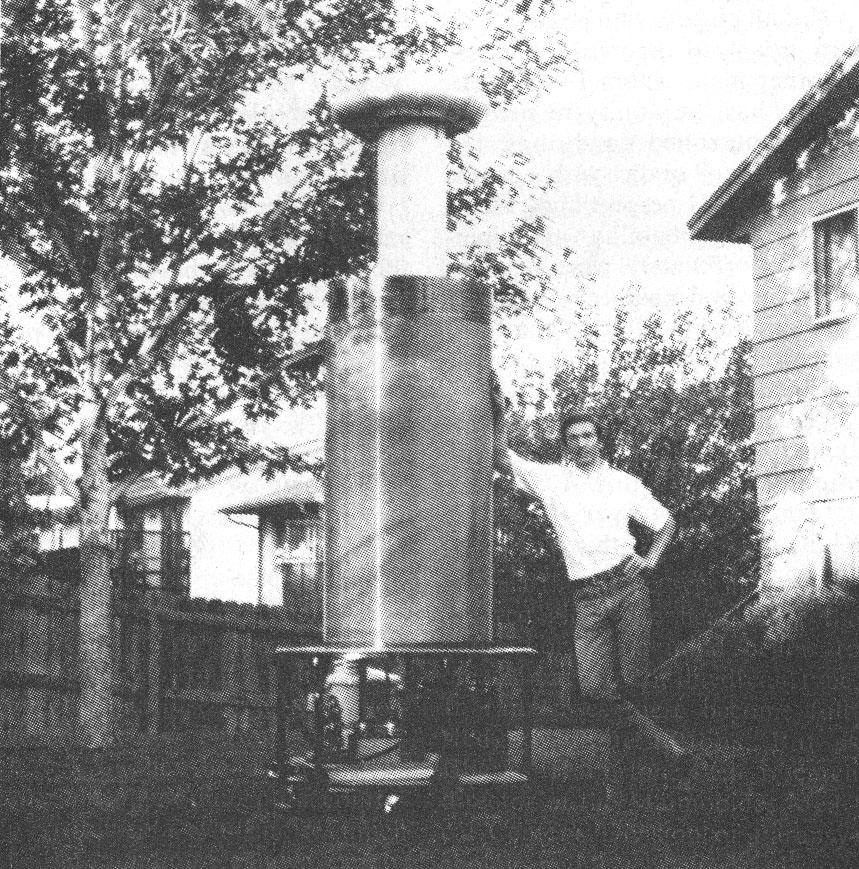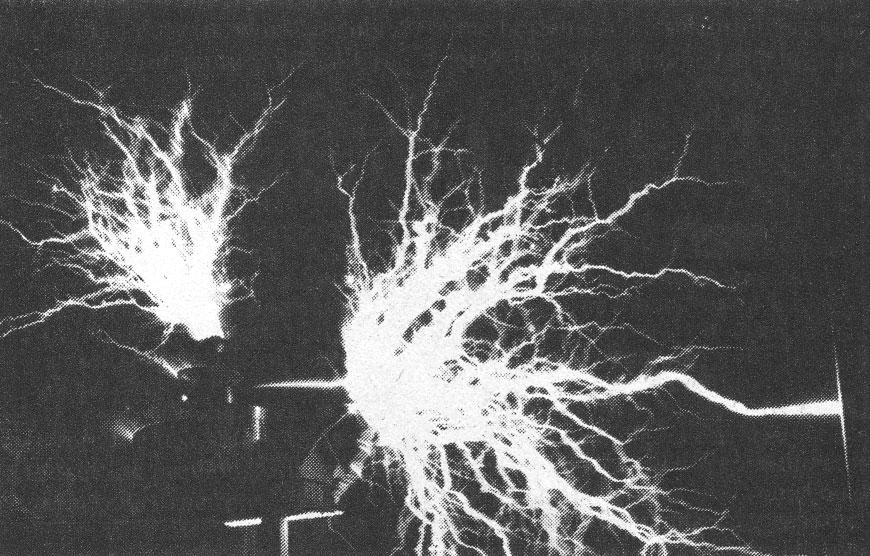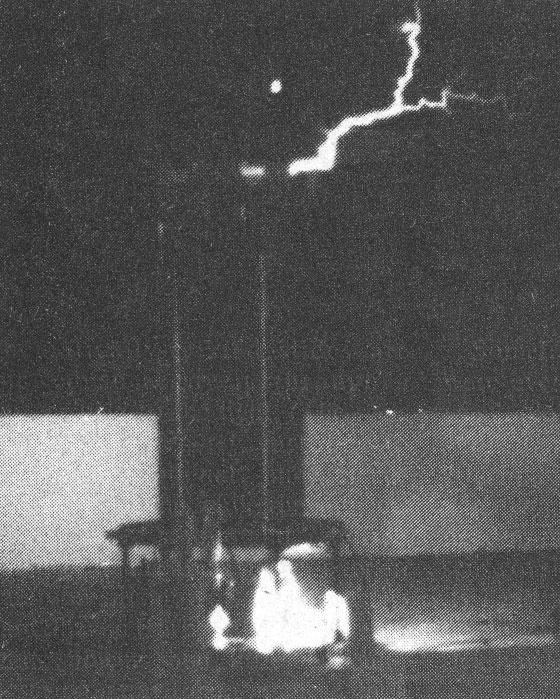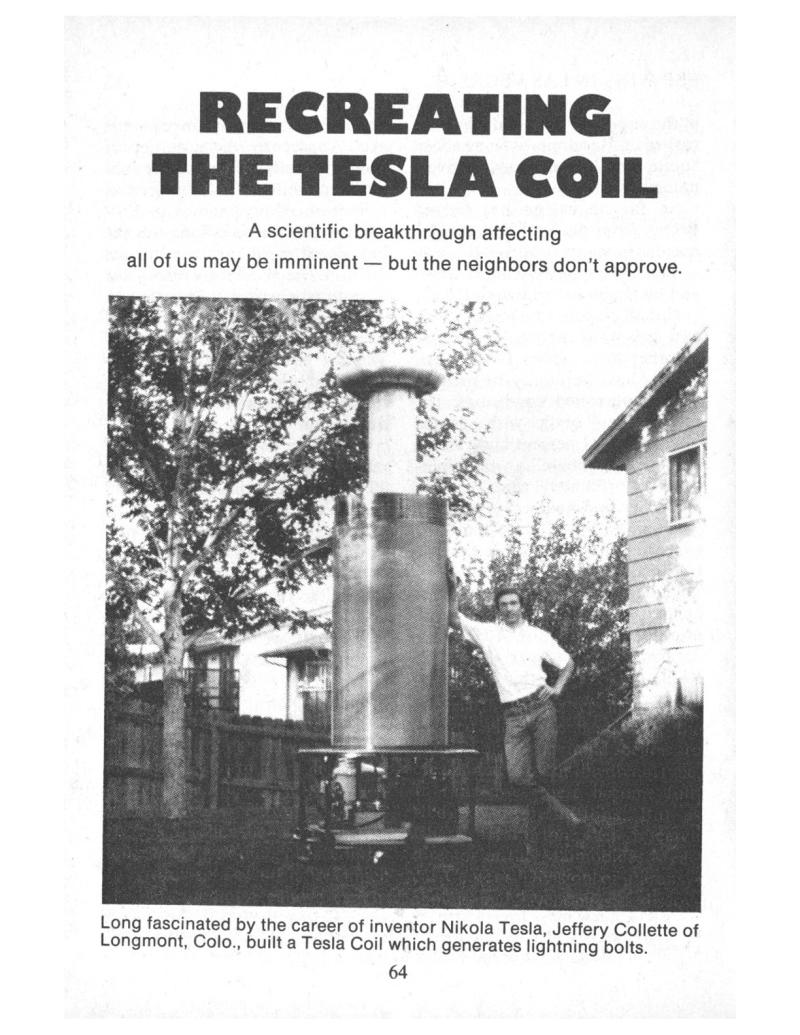
Nikola Tesla Articles
Recreating the Tesla Coil
A scientific breakthrough affecting all of us may be imminent - but the neighbors don’t approve.
Long fascinated by the career of inventor Nikola Tesla, Jeffery Collette of Longmont, Colo., built a Tesla Coil which generates lightning bolts.
At Denver convention in 1986 Jeffery Collette demonstrated his Tesla Coil, producing effects akin to ball lightning - “plasma energy.”
It would be ironic, although typical of human perversity, if a major scientific discovery was abandoned because of a local noise ordinance.
Imagine this:
You notice one of your neighbors is erecting a large machine in his backyard. Curious, you watch as he finishes constructing the device and fires it up. Then you are startled to see 30-foot lightning bolts shooting from the contraption. Would you marvel at this wonder, like a child at a Fourth of July fireworks display? Or would you panic and call the police, fearing you might be fried to a crisp or your house set ablaze?
If you are the kind of person who would notify the authorities, you would not have enjoyed being Nikola Tesla’s neighbor. Nor would you relish residing next to Jeffery Collette. But if you have an inquiring mind and a natural curiosity, Tesla and Collette would be just the kind of people you would love to have next door.
Nikola Tesla was born in 1856 and died in 1943. During his lifetime he achieved a scientific prominence few have matched and he performed astonishing feats none have been able to duplicate. One of his experiments involved giant coils, artificial lightning and mysterious balls of light. Many researchers, both professional and amateur, have worked on the Tesla Coil or some variation thereof but few have consistently reported success creating those balls of light - until now.
Collette operates his Tesla Coil in his backyard, annoying neighbors who have complained about noise the device generates. Collette is now seeking new quarters in which to pursue his work.
Tesla was born in Smiljan, Austria-Hungary, which is now part of Yugoslavia. He attended a school in Graz and the University of Prague. After a stay in France he traveled to the United States in 1884.
His accomplishments were prodigious. Tesla invented the alternating-current induction motor. He patented the rotating field motor in 1888. Tesla, not Thomas Edison as many mistakenly believe, developed our system for electrical-power distribution. He registered hundreds of patents. Tesla invented the bladeless steel turbine and the polyphase electric motor. He was a pioneer in the development of what he called “automatons,” better known to the rest of mankind as robots. Tesla produced the first practical reciprocating dynamo. In 1943 the U.S. Supreme Court found in his favor in an important case, ruling in effect that it was Tesla, not Marconi, who invented the radio. The list could go on.
In 1899, in Colorado Springs, Colo., Tesla built enormous coils in his square barnlike laboratory. These huge coils were able to generate over 10 million volts of electricity. Witnesses describe bolts of man-made lightning flashing 135 feet in the air, creating claps of thunder reportedly heard 15 miles away.
To date few people have successfully replicated Tesla’s work with his famous coils.
Until now.
Jeffery Collette is a 29-year-old resident of Longmont, Colo. As a child, his parents say, he was always taking things apart to “see how they worked.” At the age of eight he converted friction cars to battery-operated vehicles. His intense interest in electronics reached a turning point in 1984, the year a friend introduced him to Nikola Tesla. Collette became fascinated by the Tesla Coil and out of this fascination he constructed a functional Tesla Coil able to generate lightning bolts 30 to 40 feet in length.
The implications are tremendous.
Tesla believed he could produce wireless power by using the earth’s own resonance. He dreamed of providing electrical energy to everyone on the planet and of being able to do so without depleting our natural resources. Toward that end he was experimenting with his massive coils in Colorado Springs. Tesla’s giant coils were reportedly 75 feet in diameter and the masts nearly 200 feet tall.
Collette’s latest version of the Tesla Coil, by comparison, stands about 12 feet high and is about four feet in diameter. But his ideals are as lofty as Tesla’s. He sincerely believes his work with the coils could lead to an inexhaustible supply of inexpensive energy. Recently he observed the formation of a phenomenon few persons have been privileged to witness, a phenomenon that he thinks holds the secret to supplying worldwide power.
Some people call it “ball lightning.” Others, like Collette, refer to it as “plasma energy.”
Tesla didn’t know what to call it. While conducting some experiments in his lab, Tesla noticed an unusual occurrence: bright pinpoints or balls of light were clearly visible in the lab after his machine had been switched off. He jotted down some notes, speculating that the discovery might have possible significance in the future.
Collette wholeheartedly agrees but thinks the future is now. He has photographic evidence of detached balls of light emanating from his Tesla Coil and he believes he has captured a rare record of ball lightning or plasma energy on film. His next step is to build a machine which can generate plasma energy on demand, a larger machine because the size of the observable energy increases proportionally with the amount of power applied to the coil.
So what’s the big deal with ball lightning?
Collette says: “Ball lightning is mythical, really. There have been only a handful of people who have witnessed it in nature. A lot of people don’t even believe in its existence but there are scientists who do. There are many who believe the same thing that Tesla believed and that I believe: that it should be very significant in giving us a better insight into how to produce a controlled fusion reaction a lot cheaper and more effectively than using a laser.” So far no one has produced a controlled fusion reaction.
Collette notes that the fuel of the future could be something as common and abundant as water. Scientists have already performed a technique for extracting a substance known as deterium from water, roughly one gram of deterium from eight gallons of water. One gram doesn’t sound like much but if the deterium is used in a nuclear-fusion reactor, the energy released would be equivalent to the energy produced by burning 2500 gallons of gasoline. Perfecting our understanding of nuclear fusion is essential.
Collette puts it mildly: “It could totally change the way we live.”
There are, however, a lot of ifs in this. If Collette can construct a machine that will produce plasma energy on demand, if he has access to an ionization chamber and if he can sustain the plasma energy long enough to conduct a thorough study of the phenomenon, he feels he might be able to produce a controlled fusion reaction.
His work has come up on two pressing problems: a lack of financial resources and a paucity of parts. Anyone who has ever worked with sophisticated electronic equipment knows how expensive the components can be. And locating parts for a Tesla Coil, a device relatively few persons have ever successfully reconstructed, can be a formidable challenge. Improvisation becomes the key. You modify ordinary parts to suit your purposes or design and fabricate the needed elements from scratch, using whatever is available.
Collette has had to scrimp and save from his salary as an electronic technician to purchase the materials he requires. His version of the Tesla Coil has undergone continual evolution and subsequent modifications as he has improved on its performance. The very first coil he built was small enough to hold comfortably on his lap. Some of the later models, however, couldn’t be contained in the lap unless the lap belonged to King Kong. In his most recent device the electrode alone is over 30 inches across and about 7½ inches in diameter.
By applying his imagination and converting common parts obtained at electronics surplus stores, Collette has kept his costs to a strict minimum. Even so his newest version cost from $1200 to $1500. “That’s using bottom-of-the-line components,” he says, “and going out there scrounging and scavenging. I calculate a machine equivalent to mine with good parts would cost from $12,000 to $16,000.”
Collette’s control console cost over $200. “I built the console from the ground up in three days,” he says. “I had meant to spend three weeks on it. And I didn’t have time to test it before I took it to the convention.”
The “convention” was a science-fiction-oriented gathering held in Denver in 1986 and attended by some members of the International Tesla Society. Organized only a few years ago, the Tesla Society hopes to revive recognition of Tesla’s genius and his work. The 1986 International Tesla Symposium, a separate affair from the science-fiction event, was held at Colorado College in Colorado Springs and was attended by scientists, engineers and authors from all over.
Hundreds of people saw Collette’s Tesla Coil in operation. In 1984 Collette had demonstrated an earlier model at the Crossroads Mall in Boulder, Colo., before an estimated 2000 persons as part of a two-day vo-tech fair. Desperate for funds to continue his research, Collette has said he is toying with the notion of renting a massive building, erecting his machine and charging admission for the folks to see a genuine scientific wonder.
Collette also needs a facility he can use on a regular basis. Until October 1986 he was conducting his experiments and operating his devices in his home or in his backyard. With his latest Tesla Coil operating at peak efficiency and generating some two-million volts of electricity, his neighbors couldn’t help noticing all those lightning bolts as they flashed into the night sky. As Collette recalled when speaking to a newspaper reporter, “It was awesome!”
It was also unnerving, neighbors told Longmont police who soon showed up at Collette’s front door. He was politely informed he would have to stop disturbing the peace and creating an “unnatural sound.” His Tesla Coil produces a loud sizzling noise reportedly audible for a considerable distance.
Collette was at a dead end, with little money for his plasma research and nowhere to perform it even if he could acquire the necessary funding.
So what’s next?
Collette is as determined as ever. “I have a great deal of respect and admiration for Nikola Tesla,” he says. “After all, he did make the world we live in a much better place thanks to his ingenious inventions. And for that reason I would like to recreate Tesla’s experiments, any one of which could immensely benefit mankind.”
Collette is largely self-educated. Although he is familiar with Tesla’s life story and amazing accomplishments, he has not availed himself of any of the scientific information and schematics offered by various publishers and reputedly written by Tesla. Collette put it to me this way: “If the information is already available, it’s not much of a challenge. But if you have to really think about it, it can lead to bigger and better things.”
In addition to the Tesla Coil, Collette is actively working on another Tesla invention: a mechanical oscillator. Tesla, says Collette, “was able to introduce vibrations into different structures. Once he had calculated the resonant frequency, he would tune his device to that resonant frequency.
“Here’s a simple way to understand it: If you hit an object on the end, it sends a sound wave along the material which will return to its point of origin. What Tesla did is that he added a pulse every time the wave would return. He would reinforce it with another one and then hit it again and add another one. He’d make that happen maybe thousands of times a minute. By doing that, he would build up the energy levels of the molecular structure of the material. It would eventually reach a point where it would fly apart. It would built up so much energy that it would totally devastate the object. It would rip it apart.”
Tesla once boasted he could generate resonant tremors at a precise frequency and cleave the planet in two.
Collette emphasizes that his research and devices will have only “peaceful ramifications,” although he is well aware that Tesla’s work has many military applications. Dr. Stefan Possony, associate editor of Defense & Foreign Affairs, has asserted that Tesla’s inventions and ideas could have considerable significance in developing weapons systems. Collette concurs and he even speculates on the benefits Tesla’s concepts could bring to the controversial Strategic Defensive Initiative (popularly known as “Star Wars”) program advocated by President Reagan.
Collette’s research has had its lighter moments. There was the time he fired up his Tesla Coil and blew out the main circuit breaker in his house. On one occasion he put on a demonstration of the machine for a select group of guests. When lightning bolts started flashing, one guest made an abrupt and unscheduled departure.
Phil and Lorraine Collette have been remarkably understanding of their son’s experiments. They encouraged him at an early age. They don’t mind fried circuit breakers and streaks of man-made lightning illuminating their windows. They even permitted Jeffery to conduct a demonstration of an earlier model in the family dining room. The room filled with a strong odor of ozone, three-foot-long bolts narrowly missed the chandelier and the upright piano, and the room was transformed into a crackling imitation of the set for The Bride of Frankenstein. But Mr. and Mrs. Collette never said a word.
When I asked them how they feel about their son’s work, Mrs. Collette said, “We get a charge out of it!”
The charges may be few and far between if Collette cannot locate a facility for his research. He says he could fill an entire page with a wish list of test equipment he needs to expedite his experimentation, items such as a spectrum analyzer and a device for measuring magnetic fields.
Collette, like his mentor Tesla, hopes to accomplish the incredible. It would be a shame to see his work abruptly curtailed at such a promising stage by a local noise ordinance.



